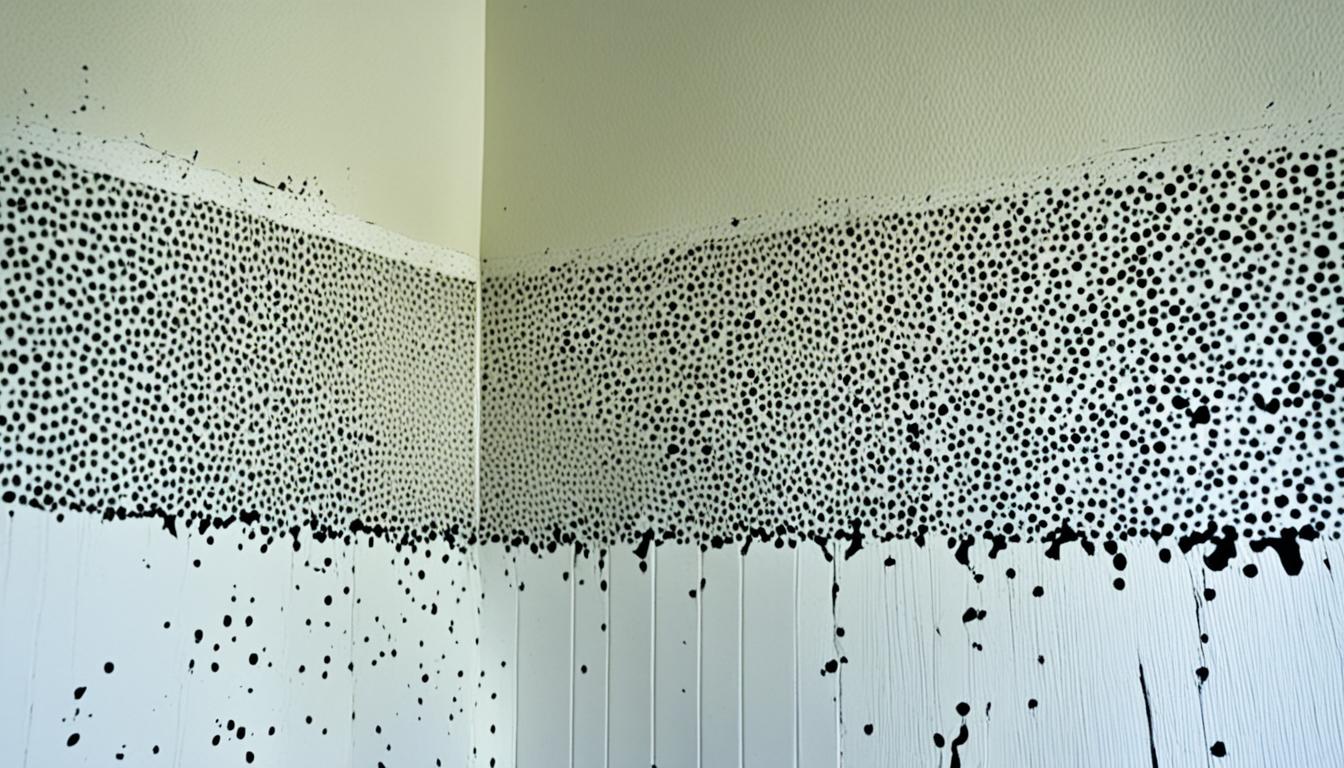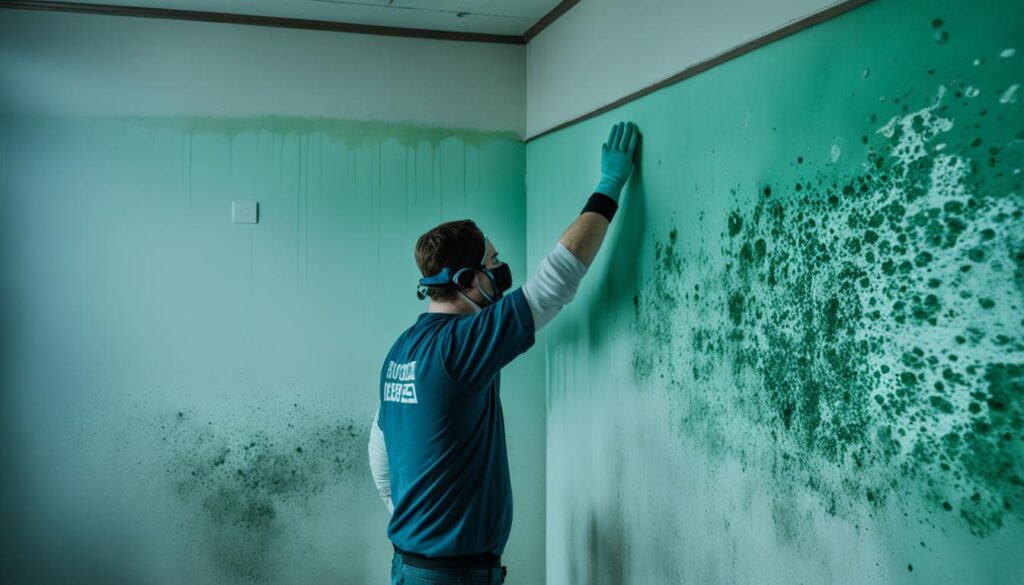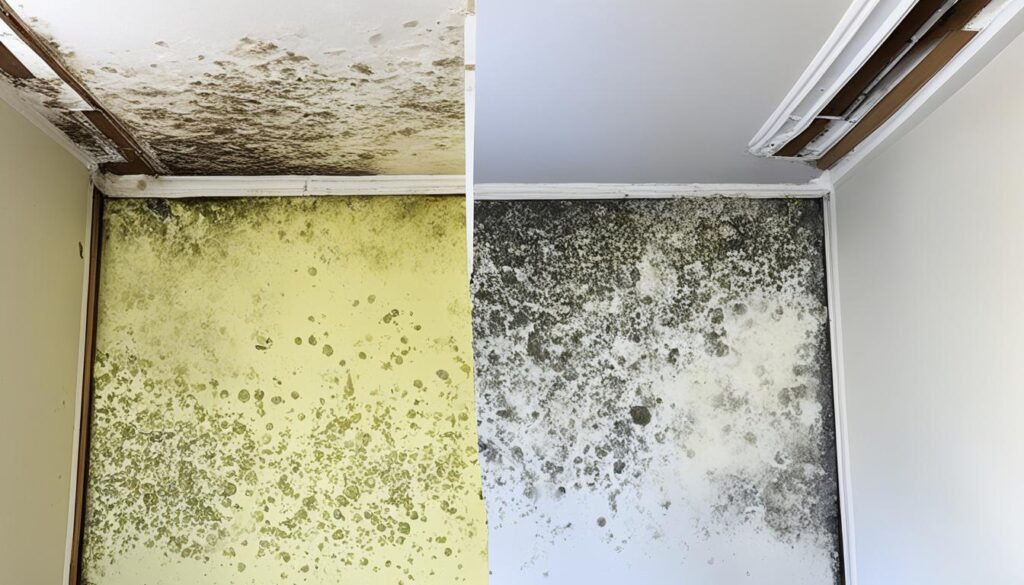
Signs of Mold in Residential Property Explained
Are you concerned about the presence of mold in your residential property? Recognizing the signs of mold early on is crucial for taking appropriate action and safeguarding your home and health. In this section, we will explore the signs and indicators that can help you identify the presence of mold in your residential property.
Key Takeaways:
- Mold can have various effects on the inhabitants of a home.
- Recognizing the symptoms of mold exposure is crucial for early detection and remediation.
- Visible signs such as discoloration, musty odors, and water damage can indicate mold growth.
- Additional signs of mold growth include condensation, high humidity levels, and the presence of mold colonies.
- Mold can pose serious risks to both the structural integrity of your home and the health of its occupants.
Mold Symptoms in Home
Mold can have various effects on the inhabitants of a home. In this section, we will discuss the common symptoms of mold exposure, both physical and respiratory, that may indicate the presence of mold in your residence. Recognizing these symptoms is crucial for early detection and remediation.
When mold spores are present in the air, they can cause a range of symptoms. These symptoms can vary in severity depending on the individual’s sensitivity and the extent of mold infestation in the home.
Physical Symptoms
Exposure to mold can lead to several physical symptoms, including:
- Itchy or irritated skin
- Watery or red eyes
- Nasal congestion or runny nose
- Sneezing and coughing
- Sore throat
If you or your family members experience these symptoms, especially when spending time indoors, it may be a sign of mold presence in your home.
Respiratory Symptoms
Mold exposure can also have respiratory effects, causing symptoms such as:
- Shortness of breath
- Wheezing or chest tightness
- Asthma attacks or increased asthma symptoms
Individuals with pre-existing respiratory conditions, such as asthma or allergies, are often more susceptible to these respiratory symptoms when exposed to mold.
Quote: “Recognizing the symptoms of mold exposure is crucial for early detection and remediation.” – Dr. Sarah Thompson, Environmental Health Expert
If you or your family members experience any of these symptoms on a regular basis, it is important to investigate for the presence of mold in your home. Timely detection and remediation can significantly improve your health and prevent further mold-related issues.
Now that we have explored the symptoms of mold exposure, let’s move on to the next section to learn how to identify mold in your property.
Identifying Mold in Property
When it comes to mold growth in your property, early detection is crucial. Recognizing the visible signs and indicators of mold can help you address the issue before it becomes a major problem. By being vigilant and knowing what to look for, you can protect your property and the well-being of its occupants.
Common Warning Signs
There are several warning signs that can indicate the presence of mold in your property. These signs may vary depending on the type of mold and the affected area. Here are some key indicators to be aware of:
- Discoloration: Mold can often cause discoloration on surfaces. Look for patches or spots that appear green, black, brown, or yellow.
- Musty Odors: The presence of mold is often accompanied by a strong musty smell. If you notice an unpleasant odor that persists, it could be a sign of hidden mold.
- Water Damage: Any past or current water damage, such as leaks or flooding, can create a conducive environment for mold growth. Inspect areas that have experienced water-related issues carefully.
- Peeling Paint or Wallpaper: Mold can cause paint or wallpaper to peel, bubble, or warp. Pay attention to any changes in the appearance of your walls or ceilings.
These warning signs serve as an initial indication that mold may be present in your property. If you come across any of these signs, it’s essential to investigate further to determine the extent of the mold problem and take appropriate action.

Professional Mold Assessment
While identifying visible signs of mold is a good starting point, some mold growth may be hidden from view. In such cases, it’s advisable to seek the assistance of a professional mold assessment service. Trained professionals have the expertise and tools necessary to detect hidden mold and assess its potential impact on your property.
Fix Mold Miami offers comprehensive mold assessment services to help you determine the extent of mold growth in your residential property. Their team of experienced professionals can provide a detailed inspection and assessment, offering you peace of mind and guidance for effective mold remediation.
Don’t ignore the warning signs of mold in your property. Addressing mold issues promptly can prevent potential health hazards and minimize property damage. Stay vigilant, be proactive, and seek professional assistance when needed. By taking these steps, you can ensure the safety and well-being of your property and its occupants.
Signs of Mold Growth in a Home
When it comes to mold growth in a residential property, it’s important to be able to spot the signs early on. By being proactive in identifying these indicators, you can take immediate action to prevent further mold growth and ensure the safety of your home and family.
Condensation
One of the key signs of mold growth is the presence of condensation on surfaces such as windows, walls, or pipes. Excessive moisture buildup can create an ideal environment for mold to thrive. If you notice frequent condensation in your home, it’s essential to investigate further and address any underlying moisture issues.
High Humidity Levels
Elevated humidity levels can also contribute to mold growth. If the humidity in your home consistently exceeds 60%, it can create a favorable habitat for mold spores to reproduce. Utilizing dehumidifiers or improving ventilation in areas prone to moisture, such as bathrooms and basements, can help mitigate the risk of mold growth.
Persistent Musty Odors
A strong musty smell in your residence is often a reliable sign of hidden mold. Take note if the odor is persistent and seems to originate from a specific area or room. It’s crucial to investigate further, as the source of the odor may indicate a hidden mold infestation.
Visible Mold Colonies
Visible mold colonies are an obvious indication of mold growth. Keep an eye out for discoloration on walls, ceilings, or other surfaces. Mold can appear as black, green, or brown patches and may have a fuzzy or slimy texture. Remember, mold can grow in hidden or hard-to-reach areas, so be thorough in your inspections.
The Dangers of Mold in a House
Mold can pose serious risks to both the structural integrity of your home and the health of its occupants. It is important to be aware of the potential dangers associated with mold growth in a house, as timely detection and remediation are crucial for ensuring a safe living environment.
One of the primary concerns when it comes to mold is the health effects it can cause. Exposure to mold spores can lead to various respiratory issues, including coughing, wheezing, and shortness of breath. Individuals with allergies or asthma may experience aggravated symptoms, making it difficult to breathe properly.
Furthermore, mold can trigger allergic reactions in susceptible individuals, causing symptoms such as sneezing, nasal congestion, itching, and watery eyes. Prolonged exposure to mold can also contribute to the development of more severe health conditions, including sinus infections and respiratory infections.
In addition to the health risks, mold growth can deteriorate the structural integrity of your home over time. Mold thrives in damp environments, and its presence is often an indication of excess moisture or water damage. If left untreated, mold can cause significant damage to building materials, including wood rot, weakening the structure’s stability.
Moreover, mold can also lead to the growth of additional harmful microorganisms, such as bacteria and fungi, further compromising the indoor air quality and posing additional health hazards.
To mitigate the dangers of mold in your house, it is essential to address any signs of mold growth promptly and effectively. Regular inspections, moisture control, and proper ventilation are key preventive measures. If you suspect mold in your home, it is advisable to consult a professional mold remediation service for a thorough assessment and appropriate remediation.
“The presence of mold in a house not only threatens the health of its occupants but also compromises the structural integrity of the property. Timely detection and remediation are crucial for safeguarding both.”
The Hazards of Mold in a House:
- Allergic reactions and respiratory issues
- Aggravation of allergies and asthma symptoms
- Increased risk of sinus and respiratory infections
- Structural damage and wood rot
- Compromised indoor air quality
Preventing Mold in Residential Properties
Taking proactive measures to prevent mold growth is essential in maintaining a healthy living environment. By implementing preventive steps and best practices, you can minimize the risk of mold in your residential property. Here are some effective strategies to help you prevent mold:
Ventilation
Proper ventilation is crucial for reducing moisture levels in your home, as mold thrives in damp environments. Ensure that your kitchen, bathroom, and laundry areas are adequately ventilated. Consider using exhaust fans and opening windows when possible to improve air circulation.
Moisture Control
Moisture control is key to preventing mold. Fix any leaks or plumbing issues promptly, and regularly inspect areas prone to moisture accumulation, such as basements, crawl spaces, and attics. Use dehumidifiers to maintain optimal humidity levels, typically between 30% and 50%, and avoid overwatering indoor plants.
Regular Inspections
Regular inspections can help you identify and address moisture or mold-related problems early on. Take the time to check areas susceptible to mold growth, such as behind appliances, under sinks, and around windows. If you notice any signs of moisture or mold, take immediate action to prevent further spread.
Clean and Dry Spills Promptly
Accidental spills can happen, but it’s crucial to clean and dry them promptly to prevent mold growth. Whether it’s a small water spill or a larger incident, invest in absorbent materials and clean the affected area thoroughly. Avoid leaving wet items or damp surfaces unattended for extended periods.
Properly Maintain Your HVAC System
Your heating, ventilation, and air conditioning (HVAC) system plays a vital role in preventing mold. Regularly clean and inspect your HVAC system to ensure optimum performance. Replace filters as recommended by the manufacturer and consider using high-efficiency particulate air (HEPA) filters to trap mold spores effectively.
By following these preventive measures, you can significantly decrease the risk of mold in your residential property, providing a healthier living environment for you and your family.
Implementing proactive strategies to prevent mold growth is essential for maintaining a healthy living environment. By focusing on ventilation, moisture control, regular inspections, prompt cleaning of spills, and proper HVAC system maintenance, you can effectively minimize the risk of mold in your residential property.
Professional Mold Assessment and Remediation
When faced with an extensive mold problem or if you are uncertain about the extent of mold growth in your residential property, it is crucial to seek professional help. Don’t take chances with your health or the integrity of your home. Fix Mold Miami is here to provide reliable, efficient, and comprehensive mold assessment and remediation services.
Fix Mold Miami is a reputable service provider with years of experience in the industry. Our team of certified mold experts has the expertise and cutting-edge technology to accurately assess and identify mold issues in your property.
With our state-of-the-art equipment and thorough mold inspection process, we can detect hidden mold growth, even in hard-to-reach areas. By uncovering the root cause of the problem, we can develop a customized remediation plan tailored to your specific needs.
Our highly trained technicians follow industry best practices and use the most effective mold removal techniques to ensure that your property is completely free from mold. We take every precaution to protect your health and minimize any disruption to your daily life during the remediation process.
At Fix Mold Miami, we understand the importance of providing prompt and reliable service. We take pride in our quick response times and our commitment to delivering exceptional results. Your satisfaction is our top priority.
Why Choose Fix Mold Miami?
- Experienced professionals: Our team consists of skilled experts with extensive experience in mold assessment and remediation.
- Advanced technology: We utilize state-of-the-art equipment and techniques to accurately detect and remove mold from your property.
- Customized solutions: We develop personalized remediation plans tailored to your specific mold issues and property requirements.
- Prompt response: We understand the urgency of mold problems and strive to provide quick response times for our customers.
- Exceptional customer service: Our friendly and knowledgeable staff is here to guide you through the entire process and address any concerns you may have.
To schedule a thorough mold assessment or to learn more about our services, contact Fix Mold Miami at 305-465-6653. Don’t wait until mold becomes a major problem. Take control of your indoor environment today.

| Services Offered | Benefits |
|---|---|
| Mold assessment | – Accurate identification of mold issues – Comprehensive inspection process – Detection of hidden mold growth |
| Mold remediation | – Customized remediation plans – Effective mold removal techniques – Minimization of health risks |
| Prevention | – Expert advice on mold prevention – Moisture control strategies – Comprehensive solutions for long-term mold prevention |
| Quick response | – Prompt service – Efficient mold assessment and remediation – Minimization of property damage |
Conclusion
In conclusion, recognizing the signs of mold in a residential property is crucial for maintaining a safe and healthy living environment. Mold can have detrimental effects on both the structure of your home and the health of its occupants. By being vigilant and understanding the warning signs, you can take the necessary steps to address mold issues promptly.
If you notice any discoloration, musty odors, water damage, or peeling paint, it may indicate the presence of mold. Additionally, symptoms such as allergies and respiratory issues can also be signs of mold exposure. It is essential to seek professional assistance or take preventive measures to prevent further mold growth.
Implementing proper ventilation, controlling moisture levels, and conducting regular inspections are key preventive measures to minimize the risk of mold in your residential property. However, in cases of extensive mold problems or uncertainty about the extent of mold growth, it is advisable to consult a professional mold assessment and remediation service provider like Fix Mold Miami.
By understanding the signs, taking appropriate action, and seeking professional help when needed, you can effectively address mold issues and ensure the well-being of your home and its occupants. Stay proactive, and prioritize the maintenance of a mold-free living environment.




